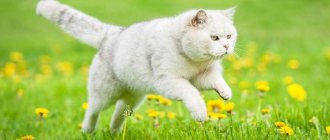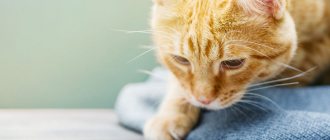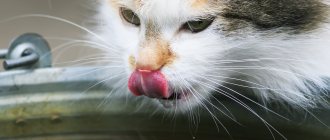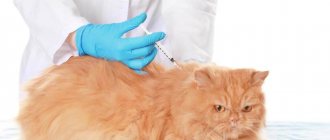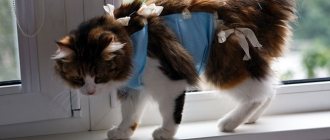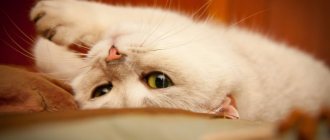For eye diseases in pets, experts most often prescribe drop therapy. Only a veterinarian at an appointment can competently explain how to put drops into a cat’s eyes. Knowing the features of instillation, you can perform the procedure yourself at home.
Typically, the doctor prescribes such procedures for several days, and instillation will need to be done two or three times during the day. Properly performed manipulation should not become an unpleasant procedure for the cat.
IMPORTANT! If 2 medications are prescribed, instillation should be carried out at intervals of 10-15 minutes. Means used simultaneously will not give a positive result.
Preparing the owner and cat for a medical procedure
Before the procedure, the animal owner must thoroughly wash their hands, disinfect them and wear gloves. There must be a mask on the face.
For a cat you need to prepare everything you need:
- warm boiled water;
- clean soft towel;
- a syringe without a needle or a pipette;
- 2 sterile cotton swabs (for each eye).
The drug must be removed from the cat's field of view. First, taking her in your arms, you need to calm her down, stroke her, and talk to her in a gentle voice. The animal must be securely restrained. A calm cat can be held in your arms or simply pressed lightly against the sofa. A restless one can be wrapped in a towel, leaving only the face visible.
It is good to attract an assistant who will hold the pet or instill medicine.
Emotional mood
Do not forget to calm the cat throughout the procedure by talking affectionately to it. This works best if you imagine that in front of you is a very small child who does not yet speak, whom you persuade to eat another spoon “for dad” and “for mom.” At the same time, women instinctively raise their voices and develop gentle melodious intonations.
Naturally, you can say whatever you want and even perform children’s sayings and nursery rhymes - practice shows that they have the same calming effect on cats as they do on babies. Try not to be nervous yourself, behave calmly and confidently, and we hope our advice will help you with this.
Sequence of eye drops for a cat
Indications for eye treatment are pathological processes. For example, this is redness of the mucous membrane of the organ of vision, purulent discharge and gluing of the eyelids.
Before instilling medication into the eyes, you need to gently and carefully wipe the area around the eyes with swabs soaked in warm water to remove pus and other contaminants. Instead of water, you can use any warm tea or chamomile flower decoction.
Procedure:
- Rinse the mucous membranes of one eye first, and then the other with a cleansing solution. Remove wet residue.
- Open the tube with the pharmaceutical preparation.
- Slightly pull the eyelid down and squeeze 2-3 drops of the product into the resulting gap. During the procedure, you need to talk to the animal gently, this will calm him down.
- Massage the eyelid for 5-7 seconds for the best distribution of the medicine. The liquid should not leak onto the wool.
- Repeat the manipulation with the second eye. Do not let go of the animal for 2-3 minutes so that it does not scratch the eyeball.
The pet will feel itching or burning after the procedure. Sometimes the cat may feel severe pain. At this point she will become restless or even aggressive.
The animal needs to be rewarded with its favorite treat.
Thymogen
In fact, this medicine can be considered an analogue of Maxidin: the drug also has a pronounced immunomodulatory effect and has a beneficial effect on the pet’s immunity. The main active ingredient is alpha-glutamyl tryptophan. The product is gentle and very effective:
- It increases the speed of regeneration processes so much that it is recommended for use for ulcerative rhinitis.
- Significantly increases nonspecific resistance, which is why it is very effective in the treatment of pathologies of viral origin.
Two drops of the drug are instilled into each nostril. Frequency of use – once a day. The duration of treatment is up to five days in a row, but if necessary, this period can be significantly extended.
Animal care tips
When treating inflammatory eye diseases, animals are most often prescribed instillation - drip administration of solutions of medicinal agents. When instilling, it is necessary to correctly follow all the rules and recommendations of specialists on the administration of pharmaceuticals.
Only a veterinarian can prescribe medication correctly. A specialist should also monitor and adjust the dynamics of therapy. Uncontrolled or illiterate use of the drug can only worsen the situation. Medicines should not be expired.
Advice! The procedure should be carried out as naturally as possible, otherwise the animal will be scared and not allow the drops to be administered. The effectiveness of the manipulation will be much higher if the animal sits or lies in a calm state.
If the kitten cannot wash itself, then the owner should help it daily using boiled warm water or weak tea leaves.
Inflammation of the eyes is a common symptom in small kittens. A problem detected in time will help to avoid major health problems, and competent assistance will stop the development of the disease. The health of a pet primarily depends on its owner.
Help from professionals
If, despite all your efforts, the animal does not get better within 7-10 days, but, on the contrary, its condition worsens, then you should immediately contact a veterinary clinic to avoid the development of pneumonia. The same should be done if a cat’s usual runny nose turns purulent. These symptoms indicate the animal’s weak immunity and require complex drug treatment, which can only be prescribed by a doctor. Now you know why your furry pet may have a runny nose, and how to help him get rid of this unpleasant health problem.
Take the advice of experts and be kind to your pet, because now, more than ever, he needs care and your attention.
Having recovered, he will return all the affection to you in full and will gratefully rub against your legs. Health to your purr and sweet cat dreams!
Common diseases
Classification of eye pathologies in cats, symptoms characteristic of each disease:
| Disease | Description and symptoms |
| Conjunctivitis | Occurs due to the entry of a foreign body, trauma to the mucous membrane, exposure to chemicals, and diseases of infectious origin. Characterized by swelling in the eyelid area and a large volume of purulent discharge. The disease can be transmitted from a sick cat to a healthy one. |
| Glaucoma | An increase in pressure in the eyeball can cause clouding of the cornea. The pathology often causes blindness. |
| Keratitis | Inflammation of the cornea is observed with clouding of the mucous membrane of the eyes and increased tearing. |
| bulging eye | Protrusion of an organ occurs due to its damage or the development of a neoplasm. Pathology is fraught with organ loss. |
| Violation of the lacrimation process | Blockage of the tear duct, as well as excessive secretion of fluid. The animal experiences severe discomfort, and the ability to see deteriorates. |
| Cataract | Characterized by clouding of the lens. The eye becomes smoky usually in adult animals and cats suffering from diabetes. |
To prevent the development of any eye disease, a systematic examination of your pet by a veterinarian is required. Without timely treatment, not only a malfunction of the visual system is possible, but also an increased risk of vision loss.
Types of eye drops
Eye drops that are used to treat the eyes of cats are divided according to the type of action:
- Antibacterial. These drugs contain antibiotics. They are used in the treatment of infections caused by bacteria (keratitis, conjunctivitis, blepharitis, etc.).
- Antihistamines. These remedies are used to eliminate allergic reactions accompanied by redness of the mucous membrane of the eyes, copious clear discharge, and swelling of the eyelids.
- Antiseptic. These medications are effective for eye diseases complicated by fungus. They cleanse the mucous membrane of pus and other secretions and disinfect affected tissues.
- Antiviral. They are used for viral infections that affect the pet’s eyes (rinotracheitis, etc.). The main component of such drugs is interferon. Drops stimulate local immunity and speed up the healing process. Often such drugs are prescribed in conjunction with antibiotics.
- Anti-inflammatory. These drugs contain components that quickly relieve the inflammatory process. They are used to treat injuries, inflammation caused by mechanical damage, conjunctivitis and other ailments.
- Moisturizing. Such drops are not used for treatment, but they are effective for increased dryness of the cornea. Some drugs contain components that can prevent the development of keratitis and other diseases.
You should not prescribe the drug yourself. If your cat has problems with its eyes, you should show it to an ophthalmologist, who will prescribe a competent treatment regimen.
IMPORTANT! Incorrectly selected medications can only aggravate the course of the disease, which will lead to complications and even blindness of the pet.
Reviews
“When I
was diagnosed with blepharitis , the doctor immediately said that it was impossible to “wait out” the disease, much less treat it with folk remedies - it would only get worse. I was immediately prescribed norfloxacin , which had to be instilled three times a day, but the doctor had nothing against additional herbal lotions.
The treatment took me only a week , and as a result I did not feel any consequences of the disease.”
Evgeny Sholokhov, Orenburg.
“When I get conjunctivitis (and this happens consistently every 2-3 years due to the unfavorable conditions of my work), I buy albucid and levofloxacin .
These products always help me , and it is not always necessary to use both types of drops at once.
The disease goes away quickly , but what is most important for me is that I do not have painful reactions , which sometimes occur in people, judging by the reviews.”
Tsiprovet
Ciprofloxacin, which is the basic substance of the drug Ciprovet, causes anti-inflammatory, antimicrobial and bactericidal effects. Medicine is prescribed if eye diseases in a cat are caused by the active development of Pseudomonas aeruginosa, mycoplasma, Staphylococcus aureus, and chlamydia. Tsiprovet is used during the preparation of animals for eye surgery, as well as at the rehabilitation stage.
When the initial symptoms of the disease are detected, one drop of the drug is administered three times a day. The course duration is seven days. In complicated cases, when the eyes begin to fester, the dose for adult cats is doubled. For kittens older than seven days, one drop is enough.
Groups of drops
Note! There are three groups of antibiotic drops, from which you can select drugs to target specific pathogenic bacteria.
In ophthalmology, drugs of one of the following types are used:
- Aminoglycosides . The principle of operation of such solutions is based on the effect directly on the contents of pathogen cells . The active components of such drugs penetrate bacterial membranes and disrupt the vital functions of microorganisms. In turn, such drugs are divided into three generations: the first is the oldest and least effective and at the same time has a fairly large number of side effects. The most modern third-generation products not only have minimal negative effects on the body, but also fight microflora that are resistant to weaker drugs. In total there are about one hundred ophthalmic solutions of this group , but their number is growing every year. Although at the same time, some of these products are falling out of use due to the emergence of cheaper and more effective analogues.
- Fluoroquinolones . This is a relatively new group of drugs, but despite their high effectiveness, such drugs have many contraindications and side effects. This is due to the fact that fluoroquinolones are absorbed into the systemic bloodstream, through which they are distributed throughout the body. But the advantage of such drops is their activity against most bacteria and the fastest possible effect .
- Separately, there are products based on the antibiotic chloramphenicol , which disrupts the processes of protein synthesis in bacterial cells at the DNA and RNA level . Such drugs are the least expensive, have the fewest side effects (therefore they are prescribed even to children and pregnant women), but they are not always effective.
Operating principle
In general, the effect of antibiotics on pathogenic microflora can be defined as the destruction of bacteria by aggressive chemical components included in such drugs.
In practice, such drugs are divided into two types based on their principle of action: bacteriostatic and bactericidal .
It is worth noting! The former do not destroy the microorganisms themselves directly, but act on their cells so that the bacteria stop developing and multiplying and, as a result, colonies of microorganisms die out.
At the same time, at some point (when their number becomes less than critical), the body’s immune system joins the fight.





